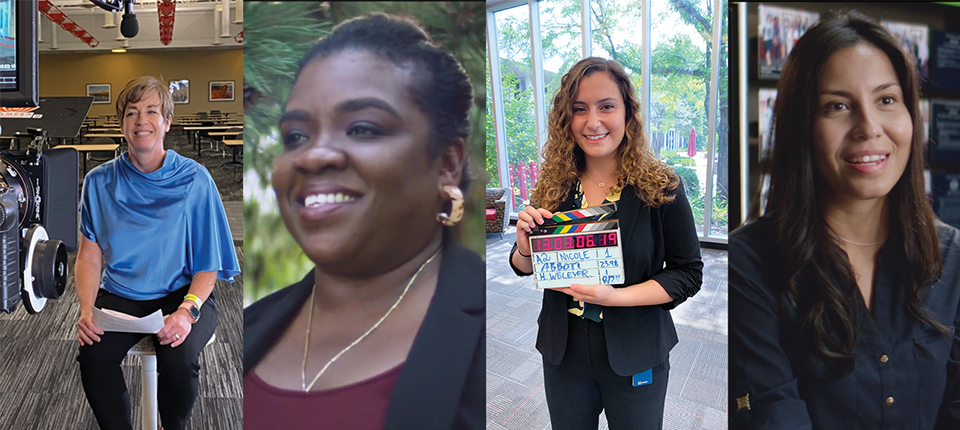
Changing the face of STEM careers for women of color
Abbott employees leading the way for more inclusive STEM careers.
Oct. 27, 2020
- Copy Link
- Share on X
- Share on Facebook
- Share on Linkedin
There's this universal experience that women in technical jobs have, and it's one that's particularly felt by women of color in STEM: You're walking into your first meeting and you notice you're the only female and/or person of color in the room. It's in that moment you realize how you're helping to narrow the gaps not just for yourself or your colleagues, but for every young girl who someday hopes to follow in your footsteps.
Women who've earned the Women of Color in STEM awards want to break down stereotypes and build up opportunities for themselves and future generations of women in STEM. They recognize the opportunities passed along to them and want to pay it forward for the next girls in line.
Speeding up the pace of progress
The opportunities in professional STEM careers continue to grow, requiring more and different types of skills and experiences than ever before. There's not a better time to attract more people to pursue careers in STEM.
"As a people of color, we are not always the majority in the room making key decisions," says Lisel Forbes, a strategic programs manager in the Diagnostics business at Abbott. "So, we have to show that our voice, our presence, and our work brings intrinsic value to the wider understanding of diversity."
Lisel Forbes - Strategic Programs Manager
However, speeding up the presence of diversity when it comes to making these key decisions requires hard work, dedication and mentorship — which Forbes has firsthand experience with.
"My mentees are the voices of the future here at Abbott," she says. "So, I want them to have the confidence to make their voices heard and have their work recognized."
Forbes isn't the only one who recognizes the value of passing the baton to others and connecting with industry leaders. Karen Rodriguez, the 2020 winner of Abbott's Career Achievement Award for Women of Color in STEM, meets with her female peers and leaders on a regular basis to discuss ways to offer more visibility of people of color.
Speeding up the pace of progress and enabling more inclusive mentorship opportunities starts with making structural and procedural changes, says Rodriguez, Divisional Vice President of Corporate Engineering at Abbott.
"We need to accelerate the pace of change," she says. "We need to be more intentional about our hiring and our promotion practices. We need to view each open position as an opportunity to become more diverse."
Inspiring the next generation
Another way to speed the pace of increasing diversity in STEM fields is to motivate the next generation of students and children of color. By showing younger generations what other people of color in STEM have achieved — and how these achievements have been applied to everyday life — they'll be more likely to show an interest and strive for these roles.
"I think as a society it's important for kids, women of color and children of color to see other people who are pursuing what they're interested in, or maybe even show them that it's possible," says Itzel Carlson, an information technology program manager at Abbott.
Itzel Carlson - Information Technology Program Manager
Carlson mentors' children at her neighborhood Boys and Girls Club, participates in Abbott STEM programs at local schools, and is the recruiting captain at Abbott's university career fairs. For Carlson, these types of involvements have allowed her to have a more hands-on approach when it comes to opening the world of possibilities in STEM for the new generation. She hopes it will inspire them to get involved in STEM early in their lives. Nicole Joison, a manufacturing process engineer with Abbott's Rapid Diagnostics business, says she hopes future generations can see more diversity in STEM for executives as well.
"I want younger generations to see more diversity in leadership roles," she says. "I think that young girls need to be inspired to understand that they can do anything that they want within a STEM field."
Similarly, Forbes seeks to foster interest and knowledge in STEM careers when she visits her old high school in Trinidad.
"I try to influence ... and understand what's going on. I try to help those young children understand what it takes to make it in STEM and how my journey evolved," she says
Inclusion in practice
Inspiring and influencing younger generations isn't a one-and-done process. Companies need to take fundamental steps in securing the next generation's interest in STEM fields. One way Carlson would like to start is by removing stigmas related to careers in STEM "by encouraging students to be lifelong learners."
Creating open environments where diversity of thought can flourish is essential to putting inclusivity into practice. Inclusive environments benefit workers, employers and younger generations — they make a difference in the lives of people all around the world. Diversity brings new ideas and life experiences to the table, and it's that kind of collaboration that will inspire the next breakthroughs in science, technology, engineering and math.
Good thing, too: Now more than ever, the world needs more curiosity and passion.
"The underlying motivation and everything that I'm doing here as an engineer at Abbott is that I want to see greater diversity in leadership roles," says Joison. "I want to inspire other people to join me in that mission because I think that there's a lot of momentum in order to change this."
Nicole Joison - Manufacturing Process Engineer
But change doesn't happen overnight. It requires persistence to keep raising your hand, persistence to make your voice and thoughts heard and persistence to pave the way for others.
For the latest on Abbott’s life-changing technology, get updates directly in your inbox.